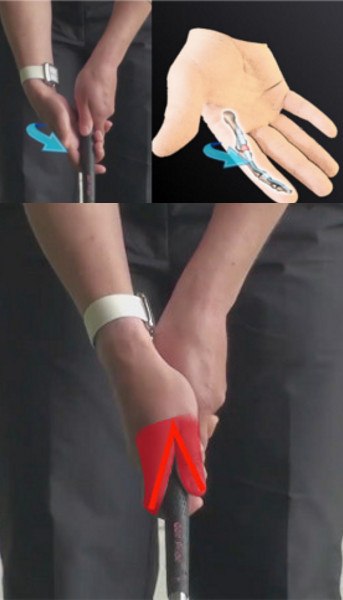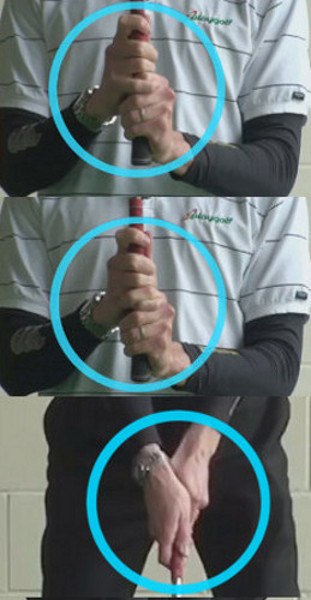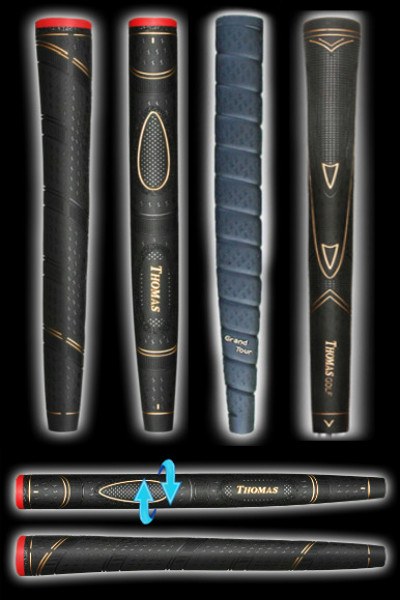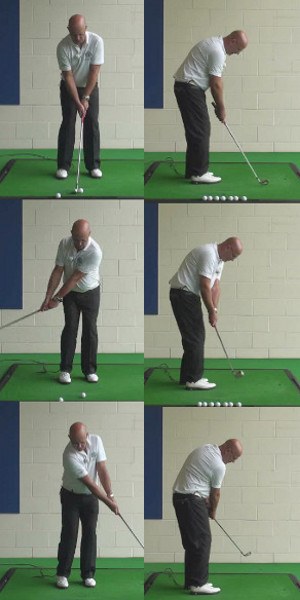
The golf grip is a hugely important part of the golf swing but much of the time the pressure in the fingers is the important key in controlling the golf club.
When putting the hands on the golf club, take proper care to ensure that the fingers are placed in the correct position. This allows the golfer to feel and understand where the pressure in the fingers should be. When putting the top hand on the golf club (left hand for right handed players and right hand for left handed players) the thumb should be positioned pointing approximately down the top centre of the golf club. When the fingers close around the club, the pressure of holding the club should be noticeable only in the top three fingers (middle, ring and little fingers). This provides a secure grip on the club but allows the top hand to relax and direct the golf club through the golf ball. The index finger is then freely available to connect with the bottom hand via the index finger and turn the two hands into one unit.
The bottom hand (right for right handed players and left for left handed players) is placed so that in the main it is the middle two fingers that hold the golf club with a small amount of pressure. The index finger and thumb rest lightly in a 'hook' around the bottom part of the grip and the little finger links the two hands together. This means that the index finger and thumb can be loose on the club but still hold it securely giving the golfer 'feel' through the swing. The middle two fingers of the bottom hand are where the pressure of the grip is contained and secures the bottom hand on the golf club.
With the hands in their correct position, the important fingers involved in the golf swing are the index finger and thumb of the bottom hand. As already discussed, they create a 'hook' in which they control the club and it is this secure but relaxed position that the golfer gains the 'feel' of the golf swing. Check the position at the end of the backswing. The club should rest securely on top of the 'v' where the thumb and finger touch very much like a snooker cue in a rest. This position gives the golfer a sense of where the golf club and the club face are at that point. At impact, the finger and thumb provide all of the feedback, or feel, of the strike of the ball as they direct the club face through the impact area. At this point, they pick up all of the vibrations of impact with the ball as they pass up through the shaft of the golf club and into the hands.
For ultimate 'feel' and the ability to control the club face through the swing, make sure that the grip is positioned well on the golf club and the pressure is applied through the correct fingers to gain feel through the bottom hand and it's index finger and thumb.

Proper Swing Use of Your Fingers
Playing good golf is all about paying attention to detail. There are a number of small details which must be monitored during the swing if you are going to hit quality shots on a regular basis. While it can be a bit frustrating to have to work through all of these little swing elements on the range, your efforts will be rewarded when you see your results on the course begin to improve. The best golfers are those who work to improve their fundamentals one step at a time. If you are committed to the long-term improvement of your game, huge improvements can be seen as the result of many small steps in the right direction.
In this article, we are going to address one of the small details which will play a role in the effectiveness of your swing – the way you use your fingers. If you are anything like most golfers, you have probably not thought much about this topic previously. There are plenty of other issues to worry about when practicing your swing, after all, so it is easy to ignore the way your fingers are behaving on the grip of the club. However, despite the fact that this is a rather small detail, it is still one which is worth your attention. By spending some time thinking about how your fingers work during the swing, you will be able to check off a minor point on your golf to-do list.
Of course, with everything else that goes on during the swing, you don't really have time to actively think about your fingers when hitting shots on the course. This is why it is so important to tackle this issue in practice. Spending time on the range to make sure your fingers are working correctly will allow you to forget about this point during your rounds. The goal is to be able to put this point out of your mind when on the course, knowing that you have prepared yourself well enough that your fingers will work correctly without any conscious thought.
Is it possible to hit good golf shots without using your fingers correctly? Yes – it is. However, the important point with regard to this topic comes in the form of consistency. You need to develop consistency on the course in order to shoot low scores, and consistency is only going to be discovered when you use your fingers the right way swing after swing. Improper use of your fingers can cause the club to move all around during the swing, and those extra movements are going to make it difficult to locate the sweet spot at impact. Every golfer would love to find added consistency in their game, and training your fingers to work correctly is a big step in that direction.
All of the content below is based on a right-handed golfer. If you happen to play left-handed, please take a moment to reverse the directions as necessary.

Three Goals
Believe it or not, there are actually three specific objectives for your fingers to achieve during the swing. That may sound a bit intimidating at this point, but you will find that these three points are relatively easy to handle once you have put in a bit of practice time. Work on them one at a time until you have incorporated all three into your swing technique.
- Light grip pressure. This is perhaps the most important thing you will need to do with your fingers during the swing. While the club is in motion, you need to maintain a light amount of pressure on the grip with your fingers. Of course, you need enough pressure to maintain control over the club as it swings, but you don't want so much pressure that you restrict acceleration through the hitting area. On a scale of 1-10, where 1 is the lightest grip possible, you want to come in somewhere around a 3 or 4. Most amateur golfers grip the club too tightly, and they pay for that mistake in the way of lost distance. Later in this article, we will discuss how you can work on finding proper grip pressure in practice.
- Stable positioning. You do not want to have your fingers moving around on the grip of the club during the swing. Some players get into the habit of adjusting their grip at the top when the backswing transitions into the downswing – often, players don't even know they are making this mistake. Moving your fingers on the grip during the swing is called 'regripping', and it can make it quite difficult to hit solid shots. Take a quick look at your swing on video to check for this error, and work on correcting it as soon as possible to improve the consistency of your ball striking.
- Cooperation between hands. Your hands, and fingers, need to work together during the golf swing if you are going to achieve great results. Rather than working independently to force the club to move in various directions, your hands should team up to work together as seamlessly as possible. This point starts when you first form your grip, as your palms should face each other while your fingers wrap around the club. Also, most players will want to use some type of connecting grip – either an interlock or an overlap – to make sure the hands stay connected even when swinging at a high speed. With all 10 fingers working together toward the same goal, it will become easier to produce quality shots.
As you can see, nothing about these three points is particularly complicated or confusion. You need to maintain a light grip pressure during the swing, you need to keep your fingers in place, and you need to make sure your hands are working together. When it comes to light grip pressure and the coordination of your hands, you can actually set yourself up for success by checking on those two points at address. Before the club even goes in motion, make sure you are keeping your grip pressure to a minimum and confirm that you have set your hands in a way which will permit them to work together.
The best way to get started on the task of using your fingers correctly is simply to head to the range for a practice session. Set aside an upcoming trip to the driving range for nothing but work on your hands and fingers in the swing. This might seem like a silly way to spend your practice time, but it can pay significant dividends in the long run. Also, as these finger-related points are relatively simple and straightforward, you shouldn't need more than one or two practice sessions to have them under control. Once that work is completed, you can move on to other priorities.

Getting Comfortable with Light Grip Pressure
One of the biggest challenges facing amateur golfers is the task of getting comfortable with using a light grip pressure during the swing. This is a point which most golfers never manage to understand, no matter how long they play the game. Your swing stands to improve dramatically if you are able to use light grip pressure, but this is a task which is easier said than done. If you need to work on relaxing the grip pressure you use on the course, the process laid out below should take you in the right direction.
- To get started on improving your grip pressure, head to the short game practice area at your local course, rather than the driving range. You will wind up on the range eventually, but you want to start in the short game area so you can gradually build up to full swings. Take one of your wedges from the bag, and set a few golf balls down on the ground. Pick out a target on the practice chipping green which is around 10 or 20 yards away from your location.
- Chip these first few shots to your target while paying careful attention to your grip strength. You should be holding on to the club as lightly as possible while still maintaining control over the wedge. Since you are only hitting short shots, you don't have to worry about the club flying out of your hands or anything like that – hold on with a light grip, use your shoulders to move the club, and pitch the ball up toward the hole.
- Once you have developed some confidence in your chipping with a light grip, move back and hit slightly longer shots. Of course, you should still be paying attention to using light grip pressure at this point. The same grip pressure that served you well when chipping from 10 or 20 yards should work just find when pitching from 30 or 40 yards. Continuing progressively moving back as far as possible within the confines of the short game practice area.
- When you have run out of space around the chipping green, it will be time to move on to the driving range. However, that doesn't mean you should be reaching immediately for your driver to hit the ball as far as possible. On the range, continue with the same wedge you were using around the chipping green. Now you are going to be making full swings, trying to hit the ball down the range somewhere around 80 – 100 yards. As always, focus on the pressure your fingers are applying to the club. If you feel like you are starting to squeeze too tightly on the handle, revert back to smaller swings until you get the right feel once again.
- To finish getting comfortable with using a light grip, you simply need to continue on through the rest of your set, gradually hitting longer and longer shots as you go. Eventually, you will reach the driver and you will be hitting long drives while using light grip pressure. It should be noted that this work does not all need to be completed in one practice session. It may take two or three practice sessions to even get comfortable chipping with a light grip, and that's okay. Take your time, commit yourself to making progress at your own pace, and practice as often as possible.
The best way to think about grip pressure is this – you should be holding on to the club tight enough to maintain control, and no tighter. If you feel like you are squeezing the handle tightly at address or at any point during the swing, you likely need to back off a bit. You may struggle to get comfortable with your new light grip at first, but it should only take a short period of time before you develop confidence in this new way of swinging the club.

The Role of Your Grips
The grips you use on your clubs are going to play a big role in the way your fingers interact with the club during the swing. The right grips can actually make this game a bit easier, and the wrong grips can make it almost impossible to make a quality swing. Your fingers are never going to be able to get comfortable when you don't have the right grips, so take a few moments to review the status of this often-overlooked piece of equipment within your set.
One of the first things to check with regard to your grips is their overall condition. If you are trying to play golf with old, worn-out grips on most of your clubs, you are fighting an uphill battle right from the start. Old grips tend to be rather hard and slippery, meaning you will have to hold on tighter just to maintain control over the club. Of course, you should have just spent some time working on using a lighter grip in your fingers, so you don't want to waste that effort by using slippery grips. Replace your grips on a periodic basis to make sure you have the ability to control the club without a tight squeeze. The frequency with which you need to replace your grips depends on how often you practice and play, but once per season is a good rule of thumb for the average golfer.
When you do pick out a set of new grips, make sure they are the right size for your hands. The grips you purchase in a golf shop are usually available in at least two sizes, if not three. Test out various sizes to find the one which fits best in your hands. When you wrap your hands around a grip, you should find that your fingers just barely touch your palm when the grip is formed. If none of the grips off-the-rack quite work for your needs, consider picking the grip that is just slightly too small and then add some extra tape under the grip at installation to make it thicker. Most people don't have the equipment at home to install golf grips, but nearly every golf shop will offer the service for a small fee.
As you shop for grips, you will find that there are a number of different types of grips on the market these days. Some are extremely soft, some are rather hard, and some fall in between those two extremes. There is no right or wrong in terms of what kind of grips you select – you should simply pick the one which is more comfortable to you personally. If you play in a climate where rain is commonly a factor during your rounds of golf, think about picking a model which offers plenty of friction to avoid having the club slip during a swing. Corded grips – grips which have strips of cord laid in the rubber – offer a great deal of control, although they can be a bit hard on your hands.
Most likely, shopping for grips will only be a complicated process the first time you do it. Once you know what size and type of grip works best for your game, you can simply repurchase those same grips over and over as they wear out. It isn't necessarily cheap to fit your full set with new grips, but it is an important part of the overall maintenance of your equipment. With fresh grips, you will have a great chance to keep control over the club time and time again.

Using Your Fingers in the Short Game
There are quite a few differences between the long game and the short game when it comes to technique. That is certainly true when talking about the way your fingers should be used. By this point in the article, you should have a pretty clear picture of what it is that your fingers need to do as you swing. However, we have not yet touched on the short game, so this final section will be dedicated to just that.
To start, let's talk about putting. When on the greens, you want to use your fingers as little as possible during the putting stroke – ideally, your fingers will have nothing at all to do with the stroke. The putting stroke is a motion which should be controlled by your shoulders while the rest of your body stays perfectly still. Once you settle into your stance, you want to stand still from your toes all the way up to the top of your head. The only thing that should be moving during the putting stroke is your shoulders, as they are going to rock back and forth in order to move the putter.
As you putt, it is best to think about your fingers as being 'along for the ride'. They need to be secured in their place on the putter grip at address, but from there they will have nothing else to do. In fact, allowing them to get involved in the stroke is a sure sign of trouble, so watch out for this mistake as you practice. With quiet fingers working to your advantage on the greens, one big piece of the putting puzzle will be in place.
Stepping off of the greens, your fingers are going to have a little more work to do when you are chipping the ball. During a chipping stroke, your fingers are going to work similarly to how they work in the full swing. You want to maintain a light grip pressure, you want to keep your fingers in position throughout the motion, and you want to use your right hand aggressively through the hitting area. Any regripping that takes place during the chipping action – which is a common mistake – is going to cause serious trouble when impact arrives.
One other area of the short game which should not be overlooked is bunker play. If you happen to find your ball in a greenside bunker, your fingers will suddenly have quite a bit more work to do. Specifically, the fingers on your right hand are going to need to work hard in order to propel the club through the sand and under the ball. Good bunker play requires a great deal of hand action, and your fingers are largely responsible for bringing that action to life.
You may have not previously thought about how your fingers affect your golf swing, but they play a bigger role in the success of your game than you might imagine. Using your fingers correctly will allow the quality of the rest of your swing to shine through. Using your fingers improperly, however, will make it hard to hit good shots – no matter how good the rest of your technique may be. By using the advice contained throughout this article, you should be able to make progress in your game by improving on the behavior of your fingers. While this certainly seems like a minor point within the big picture of your game, taking steps forward on small points can add up in a big way over the long run. Good luck!






